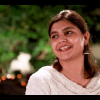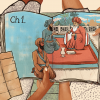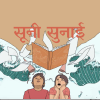Kavitha Muralidharan (KM): Vanakam (greetings). Can you share your thoughts about Sundara Ramaswamy as a family man and as a literary personality within the family?
Kannan Sundaram (KS): He was not somebody who would guide his children, shaping them in a very obvious manner, but he would create an environment that might have a positive impact on his children. All of us, my sisters and I—we were voracious readers; still are. That is obviously because of the environment that we had. There were books all around us. Even when he wants us to read a book, rather than give the book to us, he would have them put around the table. So that was the kind of influence, without saying this is a good book, read this, he will make sure that we see the book, and then we can make our own choice, either read them or not read them. And we might have different choices in selecting the books. So that’s the kind of subtle way in which he may have tried to shape us. But we all grew up very differently. My elder sister, she was a doctor, and then later in life, she decided to write. My younger sister went into music. So all of us, I think, had a cultural influence on us, in our own ways. His influence on me, I see it in two phases—one, the kind of influence we had before I went to college. I stayed in Bangalore for about 5 years. And then, the influence that he had on me after I came back from college. These two things were clearly very different for me in my relationship with my father. As a young boy, I was reading a lot of books, but I was not interacting much with them. I was obviously involved with the friends who came to the house. They would all talk to me and then they will be gone. I would sit there and observe what is happening. Then I would be very keen to ask questions about people. But I sort of maintained my distance from him. I was more into a lot of reading, and my own world of friends, things like that. But even then I was shaped by what I used to read at home. I was reading many of his books in Tamil and English.
KM: This distance that you are speaking about, is it because he is a very important literary personality? Did that have any kind of reflection in the family?
SR: We all knew that he was a writer. We felt the importance because my mother gave it a lot of importance. She made us feel that what he was doing was important. But he was into business, he was into writing, and he was very involved with all his friends and readers. That means much less time for the family. So, we were brought up more by our mother than by my father’s direct influence. And this varied in different phases. My sisters might have had a different experience. When my younger sister was born, he was more involved with the family, so she might have had a different experience. So this (my experience) wouldn’t be standard even within the family. And also because of my nature. I won’t say it was because of him that I was distant, but because of my nature. I was also in my own world, creating my own world for myself. After I came back from college, then that interaction became very intellectual, discussing things. I wanted to start a magazine. I wanted to learn a lot about Tamil intellectual works, so I was full of questions. I was very keen to interact with all the friends that came. Many of them noted at that point that I asked too many questions. That kind of learning, interacting process, from 1990 to 2005, that was a very continuous, intense process. At that point, more than father and son, we were also two people who were discussing and sharing ideas.
KM: When did he start Kalachuvadu (the literary magazine)?
KS: He started Kalachuvadu in January, 1987. That was when the first issue came out. About 8 issues came out. The last issue came in 1988. Then he wound up the magazine. This was the phase when I was away in Bangalore in college, so I had almost nothing to do with this phase of Kalachuvadu. He used to send me the magazines, I used to read them. And when I came home, I was obviously watching all that was happening. But I had no role to play in those eight issues.
KM: What was the idea behind starting this magazine, Kalachuvadu?
KS: I think in the '80s almost all the small literary magazines that were being published wound up. Sundara Ramaswamy himself had a very clear view of what is good writing, of what is good literature, short story. What is poetry? Probably he wanted to promote his school of thought through the magazine that he published. Though he had connections, unlike many Tamil writers, his connections were very international, in the sense that he was closely linked to writers in Sri Lanka, some in Malaysia, Singapore etc. So through those contacts, he was trying to bring in writings from everywhere. But at some point, he felt that he was not getting the response from the writers that he was hoping for. And also the magazine was taking time away from his writings. So for these two reasons he wound up the magazine after eight issues.
KM.: What do you think is the most important contribution of those eight issues in Tamil literature?
KS: With every issue, he would introduce a very important intellectual, for eg., an intellectual like M.N. Roy from Kerala. Also, we had special sections in every issue where a literary personality or thinker would be introduced who was completely new for Tamil writers. There is a very popular presumption when they speak of Kalachuvadu, when they would speak about Sundara Ramaswamy, the face of Kalachuvadu, they would say that it was more dedicated to literature. But if you go through those issues now, you will see that it is only an impression people gained because he himself is a creative writer. But the magazine gave a lot of space in every issue to ideas, intellectual discussions and philosophy; it was not just literature.
KM: Sundara Ramaswamy was alive when Kalachuvadu was started again, so what was his influence? Was he contributing to the magazine?
KS: So two things, before I put forth the idea of starting a magazine to him, I had waited for a few years. First thing was to take over the business that he was conducting and relieve him to be a full-time writer, so that took a few years. And in those few years, I showed him that I was capable of handling the business and also developing the business; I can do that work alone. Because I was never a good student at school or college and there was no reason for a parent to trust me with something, so I thought I should prove myself first. So the first few years, it was completely business, I was not part of anything else, and then once that was established, I brought forth the idea of starting a magazine. My feeling was that he was sceptical. And I don’t think that was wrong of him. He didn’t know what I had, or how, through my readings, I had prepared myself to start a magazine. So the first thing he did was, he didn’t say no to me, but he legally transferred the magazine name to my name. He distanced himself from the magazine to allow me to run the magazine as I wished. And then when we started the magazine, the first issue was shaping up and I could see that he felt that something very important was happening. As those pages came to us, we were doing it with desktop publishing for the very first time. So the proof used to be lying around the house at my table, he would pick them up and see them. I think he himself was very excited about what was happening, that there is a new kind of magazine shaping up. But he kept his distance, he did not want to influence this new team that was running the magazine. But he contributed his writings. He did not interfere with the process of the magazine getting its own image and going beyond his worldview or literary view. He was encouraged but he also understood that his influence should not be in the magazine. So even when he contributed, he would send a story or article he would write to whoever was the editor in-charge at the time, clearly stating that you should publish it only if you like it very much, don’t worry about turning it down, I won’t feel offended and all that. So, he was close but also distant from the magazine.
KM: How did the dining table discussions go? What were his comments on the magazine once he saw them in print, the physical form, completed form?
KS: I think, generally, he was very excited about what was happening. I went through his diary that he made from 1990 to 2000. I decided to make a selection from them and publish it in the October memorial issue of Sundara Ramaswamy this year. In that, there is a comment that I have seen Kalachuvadu today, and I am very excited about reading it. I could see it that he appreciated that something new and important was happening. We were doing something different but also very important. And he tried to guide us very gently, talking to us and showing interest but at no point did he ever try to enforce his thoughts or say don’t do this. He obviously would have resented many of the things we did and things that he didn’t like. He discussed it but there was never enforcement of what we should do or not do.
After I came back from Bangalore and started the magazine, I relieved him from the business activities until he passed away. In those 10-12 years, he wrote 15 new titles. This was more than what he wrote from 1951 to 1992 or 1993. So when he was preparing himself to be a full-time writer and wrote everything he had planned all these years, he was looking for very active publishing. The publishing company he was already publishing with was quite slow in publishing books, generally, and also with Sundara Ramaswamy’s books. And at that time, let us say, he had about existing 10 titles, at a given point only one or two will be available in print. So his articles, and short stories, then one of his novels—so those titles were not available at that time. He wanted all the titles to be printed. When we made that request to the publisher, he said that it was not possible to do that, given the limitations of the publishing company. So then he decided to part ways with the publishing company and took back all his titles. And then he was about to look for other publishing houses. So at that point, because of the need to publish all his titles, this idea of starting our own publishing company came up and we discussed it. He wanted to start a company. The books would bring in some profit and the magazine would bring in some losses, then I would not have to take money from other businesses to subsidise this institution, it could run on its own. At that point, I also realised that some of my favourite writers in Tamil like G. Nagarajan, they were also not available for readers in Tamil. So then I also warmed up to the idea of starting a publishing house not just for Sundara Ramaswamy’s writings, but also to publish all the writers that I respected, and he respected, and people who we should bring in. By the time we started the magazine, we had discovered that a significant amount of Puthumaipithan’s writings were not collected, and some of them were not even published. We were already publishing special sections in Kalachuvadu in every issue on Puthumaipithan’s collected and published writings. So these ideas were there when we started the magazines, these possibilities were all there. This phase was the post-liberalization phase of Indian economy and cutting edge inventions in DTP technology. Then came the internet in the late nineties. So all this made it possible for us to do the tasks based out of Nagarcoil and to travel to Chennai to organise the publishing house. So that also was a very important factor—the timing. There might have been other enterprises in Tamil before that with similar ideas, but many of them did not work out because they were not at the right time of history. So I think they had all the great ideas but the time was not right. Then there was C.S. Chellappa who had ideas of starting a magazine and publishing house, and he was quite aggressive in his own ways. His marketing style was a very American-influenced kind of marketing style, you know, like going door to door, meeting the customers, going to universities, going to departments. Again, it was another period of history which was not responding to his ideas. Though it was not planned, we were part of all these exciting things that were happening in India. Liberalization brought in more works, brought in more money, and that means there were a lot more readers. All these things coincided with the magazine and then the publishing house and this I think is a very important factor in why Kalachuvadu became a sustainable institution and is still running, and did not close up like all the other previous attempts in Tamil. There are two major things in every institution that came up to promote cultural writing in Tamil, either they wound up or they slowed down. You can’t think of a single institution that actually grows over 35 years of time, and that happened for the first time for Kalachuvadu and the important factor for that, I think, would be all the times that we ran that business.
KM: Sundara Ramaswamy continues to be the bestseller. Can you just speak about his titles and what contributed to his success through the years?
KS: So what has been our bestsellers is itself an interesting phenomenon. For example, Sundara Ramaswamy’s Oru Puliyamarathin Kathai was among the first two publications that we published. One was a poetry collection and the next was Oru Puliyamarathin Kathai (The story of a tamarind tree). And from then till now it is our bestseller in every single year. Maybe with the exceptions in certain years, let’s say the controversy around Mathruvahanan last year, but it has been a bestseller throughout these years. We do at least one or two prints every year, but that is from 1996 onwards. If you see from 1966 to 1996, those 30 years, I don’t think the novel went through more than three or four prints. Since then it has been selling, and again J.J.: Sila Kurippukal (J.J.: some jottings) was published in 1981 and we probably did the fourth print in 1998. And since then there have been about 20 reprints, but from 1981 to 1998, J.J. Sila Kurippukal had three prints.
I don’t think Tamil publishing itself was very sensitive to what the readers were looking for, or they were all in for new books or new ideas. For example, this would be completely unbelievable but Sundara Ramaswamy translated Thakazhi Sivasankara Pillai’s Thottiyude Makan (Son of a Sewage Cleaner) when he was 20, in 1950, and it was serialised in Sarsawati magazine, and for the first time it was brought out as a book in 2000. So nobody even thought of bringing it out as a book in all his forty years. I think it is remarkably telling of what kind of publishing scene we have. If we take the case of Chellappa, one of our bestseller novels was Chellappa’s Vaadivasal. It was a bestseller from the moment we published it in 2000, and it has been selling until now, consistently. But it never saw a single reprint before that. He brought it out, I think, at the end of 1959, and not a single time was in reprint. Chellappa himself could not sell a single edition. He offered it as a free copy if you subscribed to Ezhuthu (literary magazine started by C.S. Chellappa). And then it was never re-published. So, I don’t think that maybe the 1960s we didn’t have the market which we did in 1990s. It’s just that the publishers did not think of that as a title, because from the moment we launched it, it has been a bestseller for us, in all these 20 years.
KM: How do you think Kalachuvadu, both as a publication and magazine, is carrying forward the legacy of Sundara Ramaswamy?
KS: The legacy is of two things—one, his worldview of literature and ideas, that has been an influence on the entire team of people who were working around Kalachuvadu, in some ways influenced all of us. But at the same time, we never thought of not doing something because Sundara Ramaswamy would not have approved of it. If we thought it right, we have always done that. And that was not just when he passed away. Even when he was there, I knew when I was doing something which he did not approve of. Still, I would go ahead in publishing that book or that work. Sometimes he was right and sometimes I was right. It was immaterial. The legacy is there but we do our own thing and not blindly follow someone else’s idea.












